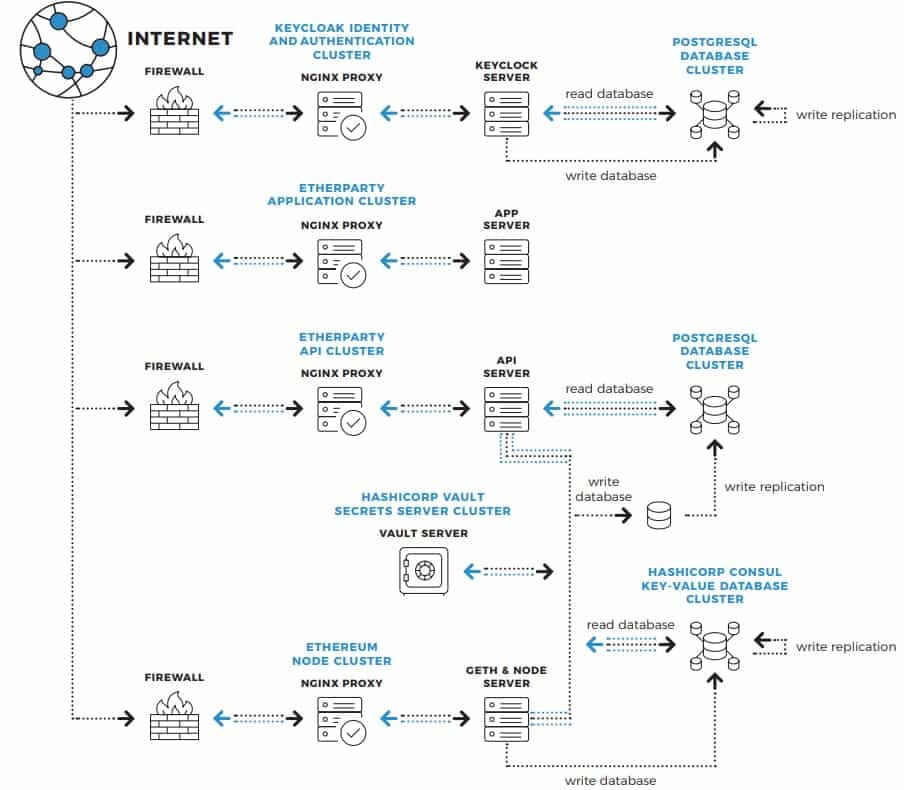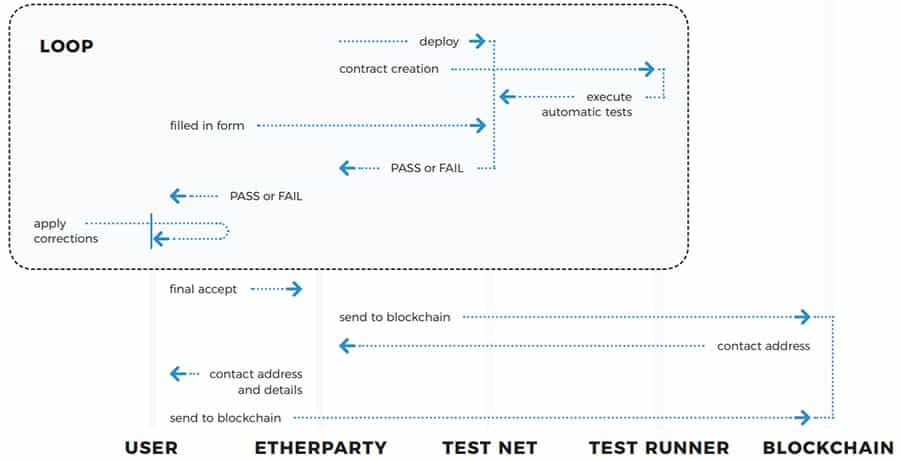Review of EtherParty: Platform for Blockchain Software Products
EtherParty (FUEL) is an interesting concept, aiming to create a tool for easily creating smart contracts on a variety of blockchains.
The initial hype around the project was high when the ICO was conducted in September 2017, but enthusiasm seems to be fading since. Still, the project is moving ahead with its vision, and has already launched Rocket, its platform for quickly and easily creating a token generation event.
In this Etherparty review, I will take a deeper look into the project and its potential in the blockchain space. You’ll learn what it is, how it works, where it came from, where it’s going, and how the FUEL token has performed, and what might be expected in the coming months and years.
What is EtherParty?
EtherParty lets people create token generation events quickly and easily, and eventually it will allow users to create their own smart contracts with just a few mouse clicks. The company believes that for blockchain technology to reach mainstream adoption it needs to be simple and approachable for businesses and the masses.

Its technology is also addressing issues faced by smart contracts such as security, cost, speed, and simplification. Solving these issues, even partially, will provide both corporate and individual users with great benefits. The EtherParty team strives to remain forward thinking and innovative, and uses automation and validation in its solutions whenever possible.
How EtherParty Works
EtherParty works with the Ethereum blockchain, using one on the main network and one for a testnet. The testnet is used to test contracts by other users before they are deployed. There are also a number of load balancing nodes which helps avoid network congestion issues.
EtherParty has been creating a library of smart contract templates. This makes it far easier for users to pick a template and create their smart contract. There’s no technical background required when choosing a template in this way, and there are both business and legal frameworks to choose from. All processing of the smart contracts and escrow will be done through the Ethereum Virtual Machine.

On the Bitcoin side EtherParty will use APIs released by Rootstock (RSK) to create smart contracts. They also state in their whitepaper that they are exploring the possibility of including other blockchains into the Etherparty ecosystem.
Creating Smart Contracts
Probably the best part of the EtherParty solution is that it will allow people with great ideas but no programming experience to build projects using smart contracts. Once the smart contracts are created the key to using them lies in FUEL, which is the EtherParty ERC-20 token. FUEL is used for management of the smart contracts, for fees, monitoring performance, managing the smart contract library, and any other costs in the ecosystem.
Currently EtherParty has a working solution for creating token distribution events, or ICOs. This solution is called Rocket and it allows companies to bypass the time-consuming and expensive ICO process with a pre-built solution.
The next development to be released will be called Comet and it is meant to be a platform for releasing securities tokens. In other words it will allow companies to digitize their stocks. Longer-term plans are for a charitable giving platform named Hero and a supply chain management solution called Saturn.
EtherParty Rocket
As mentioned, Rocket is a platform that will allow people to launch their own token generation event without the need to hire their own developers. The benefit of this is that it means a project can get off the ground much more quickly and cost effectively.
Essentially, Rocket will allow teams to create and execute the smart contracts that are required in order to launch these crowdsales. They want the platform to be an end-to-end solution for the utility token space. It has also being designed to be user friendly so that non-developers and new users can interact with it and launch the crowdsale.

Rocket launched in July of 2018 and the team has been testing it since then. They have taken user's feedback on board and they have refined the product with further updates.
While the Rocket platform is interesting, it remains to be seen whether there will be demand to launch ICOs on it in the near term. There is currently quite a bit of uncertainty in the market regarding the legal standing of ICOs and utility tokens in the eyes of global regulators.
EtherParty Security
One of the biggest concerns for project teams when outsourcing development is the security of the external code that they will be using. This is particularly relevant given the number of smart contract errors that have lead to substantial losses for projects.
EtherParty addressed these concerns in their whitepaper. For one, they make use of a modular architecture with separated storage contracts. These allow for your deployed contracts to be upgraded while still keeping the data preserved. All of the contracts that are developed on the EtherParty platform will start with their secure base templates.
In order to prevent misuse of the EtherParty platform by users, they will have to go through a diligence process before their smart contracts request can be pushed to the blockchain. Once the contract has been initiated by the user then it will have to go through a testing loop on the platform and the TestNet.

When it comes to management of private keys, these are stored in a locked vault that only the project team will have access to. EtherParty has also developed all of their Ethereum Smart Contracts with the latest version of Solidity.
Whether this will be enough to quell the concerns that people may have with contract templates is uncertain. Recent history shows that even some of the most well funded and technically advanced projects have discovered smart contract vulnerabilities. This is something individual project issuers should weigh up when choosing between a template or in-house development.
The EtherParty Team
EtherParty was conceived in 2015 by the Vanbex Group, an innovator in the blockchain space. The CEO of Vanbex is Kevin Hobbs, and he is also acting as the CEO of EtherParty. Other well known projects started by the Vanbex Group include Storj.io and Factom.
The idea for EtherParty was inspired by Counterparty, a Bitcoin protocol that simplifies token issuance. EtherParty improved on Counterparty by moving to Ethereum’s blockchain and by increasing security, scalability, and mining rewards.

The EtherParty ICO occurred in September 2017, which officially launched the project. The founding and management team have extensive blockchain and management experience. I already mentioned Kevin Hobbs, who is CEO of EtherParty and an experienced entrepreneur. Another co-founder and head of the research and development arm of EtherParty is Lisa Cheng. She has extensive experience advising start-up companies.
The team believes that their combination of business and development experience will help EtherParty grow faster.
EtherParty’s focus on the business community rather than the tech or blockchain community is somewhat unique. It’s a good focus however, since businesses are likely to need an easy and inexpensive way to utilize smart contracts. EtherParty is offering just that, and it has continued to learn and improve on its product.
EtherParty FUEL Token
As mentioned earlier the EtherParty ICO occurred in September/October 2017. The team sold $24 million in tokens in a pre-sale and then sold nearly $34 million in tokens during the crowd sale. That crowd sale lasted a full month, and the team raised just 52% of their $65 million goal. The ICO token price was $0.10.
The FUEL token is an ERC-20 token and it has a total supply of 1 billion tokens. The current circulating supply is 528,478,202 FUEL since all the ICO tokens weren’t sold. There was also 10% of the token supply reserved for the EtherParty community, beta testers and partners.
The FUEL token is a utility token that is used as gas in the EtherParty ecosystem.

After the ICO the price of FUEL fell sharply, hitting levels below $0.03 by November 2017. It then got caught up in the hype surrounding the entire cryptocurrency market in December 2017 and January 2018, rising to an all-time high of $0.431433 on January 11, 2018.
The bear market of 2018 did not treat the FUEL token well. As of November 30, 2018 the FUEL token has a value of $0.009918, or more than 90% below its ICO price. Early investors are no doubt quite disappointed in the performance of the token although this is the experience with many other projects that raised in 2017.
The FUEL token is only available on a handful of exchanges, with the highest trade volume on Binance, although there is good volume on LATOKEN as well. Gate.io and HitBTC also offer trading, but volumes are extremely low, especially at HitBTC. Given the long history of EtherParty it’s somewhat off-putting to see the token listed on such a small number of exchanges.
As an ERC-20 token the FUEL token can be stored in any ERC-20 compatible wallet.
Conclusion
EtherParty had a very good idea, but seems to have changed directions somewhat mid-stream. Focused more on ICO and token generation now, it appears investors have abandoned the project. While 2018 was a bear market in the cryptocurrencies, the FUEL token got hit especially hard due to this lack of investor confidence.
One promising development is that the team is becoming more diligent in providing regular updates on the project. If that communication continues and the planned supply chain management side of the project materializes soon I could be proved wrong in my skepticism of EtherParty.
I’ve also found it promising to see that the Rocket platform for token distribution has added KYC/AML compliance. That is almost required at this stage, and the addition will help the project attract new clients. More clients will give greater visibility to the project, and perhaps bring on new supporters and investors.
Disclaimer: These are the writer’s opinions and should not be considered investment advice. Readers should do their own research.
